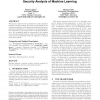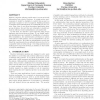382 search results - page 63 / 77 » k-Anonymity: A Model for Protecting Privacy |
CCS
2009
ACM
14 years 2 months ago
2009
ACM
We propose a framework for quantitative security analysis of machine learning methods. Key issus of this framework are a formal specification of the deployed learning model and a...
CCS
2009
ACM
14 years 2 months ago
2009
ACM
Modern computer systems permit users to access protected information from remote locations. In certain secure environments, it would be desirable to restrict this access to a part...
CCS
2005
ACM
14 years 1 months ago
2005
ACM
We present a game-theoretic model of the interactions between server and clients in a constrained family of commercial P2P computations (where clients are financially compensated...
ACSAC
2000
IEEE
14 years 2 days ago
2000
IEEE
We present a vision of computing environments in which enterprise networks are built using untrusted public infrastructures. The vision allows for networks to dynamically change d...
SP
1998
IEEE
13 years 12 months ago
1998
IEEE
A strand is a sequence of events; it represents either the execution of legitimate party in a security protocol or else a sequence of actions by a penetrator. A strand space is a ...


